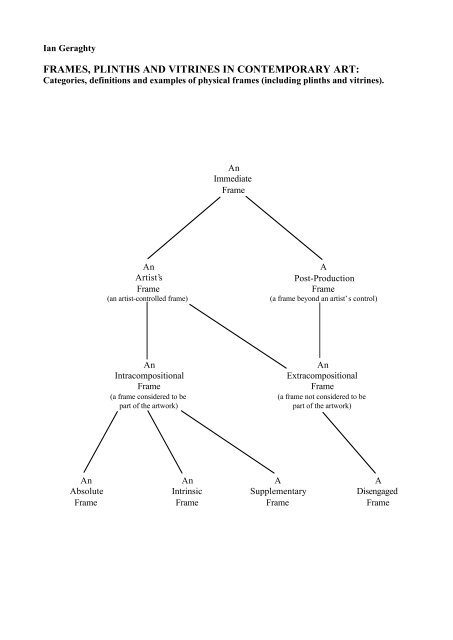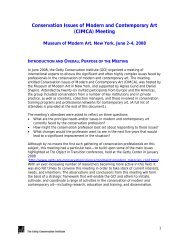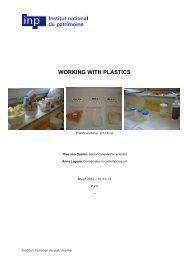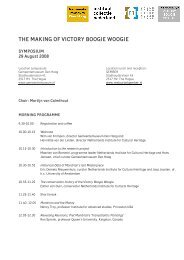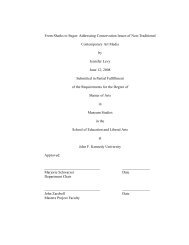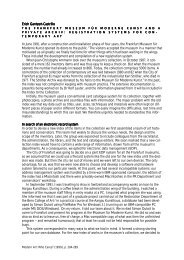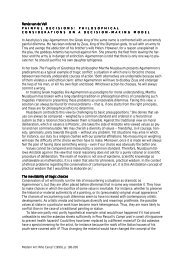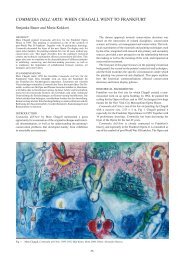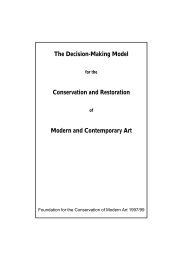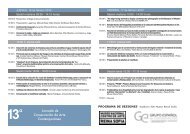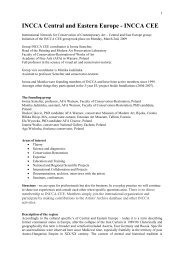frames, plinths and vitrines in contemporary art - incca
frames, plinths and vitrines in contemporary art - incca
frames, plinths and vitrines in contemporary art - incca
You also want an ePaper? Increase the reach of your titles
YUMPU automatically turns print PDFs into web optimized ePapers that Google loves.
Ian Geraghty<br />
FRAMES, PLINTHS AND VITRINES IN CONTEMPORARY ART:<br />
Categories, def<strong>in</strong>itions <strong>and</strong> examples of physical <strong>frames</strong> (<strong>in</strong>clud<strong>in</strong>g <strong>pl<strong>in</strong>ths</strong> <strong>and</strong> <strong>vitr<strong>in</strong>es</strong>).<br />
An<br />
Immediate<br />
Frame<br />
An<br />
Artist’s<br />
Frame<br />
(an <strong>art</strong>ist-controlled frame)<br />
A<br />
Post-Production<br />
Frame<br />
(a frame beyond an <strong>art</strong>ist’s control)<br />
An<br />
Intracompositional<br />
Frame<br />
(a frame considered to be<br />
p<strong>art</strong> of the <strong>art</strong>work)<br />
An<br />
Extracompositional<br />
Frame<br />
(a frame not considered to be<br />
p<strong>art</strong> of the <strong>art</strong>work)<br />
An<br />
Absolute<br />
Frame<br />
An<br />
Intr<strong>in</strong>sic<br />
Frame<br />
A<br />
Supplementary<br />
Frame<br />
A<br />
Disengaged<br />
Frame
An Immediate Frame:<br />
An ‘immediate frame’ is a frame that is immediately attached or physically connected to an<br />
<strong>art</strong>work, <strong>and</strong> which the viewer st<strong>and</strong>s on the ‘outside’ of. An ‘immediate frame’ can potentially be<br />
transported with an <strong>art</strong>work from sett<strong>in</strong>g to sett<strong>in</strong>g. It is a broad term which covers material <strong>frames</strong><br />
such as picture <strong>frames</strong>, <strong>pl<strong>in</strong>ths</strong>, <strong>vitr<strong>in</strong>es</strong> <strong>and</strong> display cases. An ‘immediate frame’ is opposite to an<br />
‘extended frame’ (an immersive k<strong>in</strong>d of frame experienced by the viewer from ‘with<strong>in</strong>’ the frame or<br />
which is passed through <strong>in</strong> order to experience a work).<br />
An Artist’s Frame:<br />
An ‘<strong>art</strong>ist’s frame’ is a frame that has been conceived, designed <strong>and</strong>/or fabricated by an <strong>art</strong>ist<br />
specifically for one (or more) of his or her own <strong>art</strong>works. This term is often used <strong>in</strong> connection with<br />
picture <strong>frames</strong> produced by <strong>art</strong>ists dur<strong>in</strong>g the mid to late n<strong>in</strong>eteenth century (such as Ford Madox<br />
Brown, Dante Gabriel Rossetti, James Abbott McNeill Whistler, Edgar Degas, <strong>and</strong> Georges Seurat)<br />
when <strong>art</strong>ists st<strong>art</strong>ed to take a more widespread <strong>in</strong>terest <strong>in</strong> how their pa<strong>in</strong>t<strong>in</strong>gs were to be presented,<br />
but examples of ‘<strong>art</strong>ist’s <strong>frames</strong>’ also precede <strong>and</strong> cont<strong>in</strong>ue on from this <strong>in</strong>fluential <strong>and</strong> relatively<br />
well documented period.<br />
A Post-Production Frame:<br />
A ‘post-production frame’ is a frame that has been added to an <strong>art</strong>work after the <strong>art</strong>ist <strong>in</strong> question<br />
has rel<strong>in</strong>quished control of its production. This <strong>in</strong>cludes <strong>frames</strong> that have been applied to <strong>art</strong>works<br />
by collectors, or <strong>frames</strong> that are the result of re-fram<strong>in</strong>g without <strong>in</strong>put from the <strong>art</strong>ist. A ‘postproduction’<br />
frame is therefore beyond the authorial control of the <strong>art</strong>ist <strong>and</strong> can be seen as the<br />
b<strong>in</strong>ary opposite of an ‘<strong>art</strong>ist’s frame’.<br />
Intracompositional / Extracompositional Frames:<br />
An ‘<strong>in</strong>tracompositional frame’ is outl<strong>in</strong>ed by John H. Pearson <strong>in</strong> his essay ‘The Politics of Fram<strong>in</strong>g<br />
<strong>in</strong> the Late N<strong>in</strong>eteenth Century’ (1990) as a frame (<strong>in</strong> both literature <strong>and</strong> pa<strong>in</strong>t<strong>in</strong>g) that is considered<br />
to be an element of the <strong>art</strong>istic composition. For example, with regard to literature, Pearson presents<br />
Cervantes’ Preface to his sequel of Don Quixote as ‘<strong>in</strong>tracompositional’ because the “Preface <strong>and</strong><br />
novel collaborate rather than rema<strong>in</strong> utterly dist<strong>in</strong>ct” (p.15). In relation to visual <strong>art</strong>, the notion of an<br />
‘<strong>in</strong>tracompositional frame’ deals directly with the question of whether a frame is <strong>in</strong>tegral to an<br />
<strong>art</strong>work or not.<br />
An Absolute frame:<br />
An ‘absolute frame’ refers to an <strong>art</strong>work which can be described <strong>in</strong> its entirety as a physical frame.<br />
The removal of the frame would remove all trace of the <strong>art</strong>work. Examples of this type of frame<br />
<strong>in</strong>clude:<br />
Piero Manzoni’s Socle du Monde (Base of the World) (1961).<br />
Gav<strong>in</strong> Turk’s Stool (1990).<br />
Gareth Jones’ Modular Pl<strong>in</strong>th (2003).<br />
An Intr<strong>in</strong>sic frame:<br />
An ‘<strong>in</strong>tr<strong>in</strong>sic frame’ is considered to be an <strong>in</strong>tegral <strong>and</strong> <strong>in</strong>separable p<strong>art</strong> of an <strong>art</strong>work <strong>in</strong> relation to<br />
its form, signification <strong>and</strong> content. It is <strong>in</strong> some way built <strong>in</strong>to the actual <strong>art</strong>work, form<strong>in</strong>g an <strong>in</strong>built<br />
frame or <strong>in</strong>-built presentation system. An ‘<strong>in</strong>tr<strong>in</strong>sic frame’ demarcates the boundary of an<br />
<strong>art</strong>work from its outer edge. A key def<strong>in</strong><strong>in</strong>g characteristic is that it constitutes p<strong>art</strong> of what is be<strong>in</strong>g<br />
presented, rather than <strong>frames</strong> what is be<strong>in</strong>g presented. It is therefore impossible or unth<strong>in</strong>kable to<br />
photographically document or expla<strong>in</strong> a work without also represent<strong>in</strong>g its ‘<strong>in</strong>tr<strong>in</strong>sic frame’. The<br />
materials for an ‘<strong>in</strong>tr<strong>in</strong>sic frame’ are <strong>in</strong>variably listed on gallery labels <strong>and</strong> ‘list of works’/room<br />
sheets etc. The removal of an ‘<strong>in</strong>tr<strong>in</strong>sic frame’ from an <strong>art</strong>work would essentially destroy the work.<br />
‘Intr<strong>in</strong>sic <strong>frames</strong>’ therefore need to be protected from wear <strong>and</strong> tear whilst be<strong>in</strong>g exhibited,<br />
transported <strong>and</strong> stored. Examples of this type of frame <strong>in</strong>clude:
The gilded frame <strong>in</strong> Jeff Koons’ Christ <strong>and</strong> the Lamb (1988).<br />
The glass <strong>and</strong> steel conta<strong>in</strong>er <strong>in</strong> Damien Hirst’s A Thous<strong>and</strong> Years (1990).<br />
The refrigeration display case <strong>in</strong> Marc Qu<strong>in</strong>n’s Eternal Spr<strong>in</strong>g (Sunflowers) 1 (1998).<br />
The Pedestal <strong>in</strong> Franz West’s Two Sculptures on a Pedestal (1998).<br />
A Supplementary frame:<br />
A ‘supplementary frame’ is conceived <strong>and</strong> developed separately from an <strong>art</strong>work - often after its<br />
completion - but is still considered to be an important (rather than an essential) p<strong>art</strong> of the work. A<br />
‘supplementary frame’ draws attention to itself as well as to what it conta<strong>in</strong>s, but it is usually<br />
regarded as secondary to what is be<strong>in</strong>g presented. Artworks with ‘supplementary <strong>frames</strong>’ are<br />
therefore often illustrated or described without their <strong>frames</strong>. However, because ‘supplementary<br />
<strong>frames</strong>’ are neither conceptually <strong>in</strong>ert nor readily replaceable, they do require an <strong>in</strong>creased level of<br />
care when it comes to the conservation of the <strong>art</strong>work. Examples of <strong>art</strong>works with ‘supplementary<br />
<strong>frames</strong>’ <strong>in</strong>clude:<br />
Helen Chadwick’s Wreaths to Pleasure series (1992-93).<br />
Hany Armanious’ Untitled hair draw<strong>in</strong>gs #2-5 (2003).<br />
Michael L<strong>in</strong>deman’s New York Ghost series (2004).<br />
John Spiteri’s An Architect’s Dream (2006).<br />
A Disengaged frame:<br />
A ‘disengaged frame’ directs attention towards the <strong>art</strong>work without ever appear<strong>in</strong>g to be p<strong>art</strong> of the<br />
<strong>art</strong>work. It rarely strays from convention <strong>and</strong> could be said to have aspirations towards ‘neutrality’<br />
or ‘<strong>in</strong>visibility’. A ‘disengaged frame’ has more of a utilitarian function than a conceptual function<br />
<strong>and</strong> is often perceived as p<strong>art</strong> of the museum/gallery furniture. It can usually be removed or<br />
replaced without drastically affect<strong>in</strong>g the content or dimensions of a work. It is therefore unlikely<br />
that a critical review of an <strong>art</strong>work would dwell upon a ‘disengaged frame’. (It should be noted,<br />
however, that certa<strong>in</strong> ‘disengaged <strong>frames</strong>’ may, <strong>in</strong> years to come, be regarded as hav<strong>in</strong>g historical<br />
<strong>and</strong> contextual significance, but this would not necessarily alter the boundary of the actual work).<br />
Examples of this type of frame <strong>in</strong>clude:<br />
Transferable museum box <strong>frames</strong> for works on paper.<br />
Generic white gallery <strong>pl<strong>in</strong>ths</strong>.<br />
Important copyright <strong>in</strong>formation<br />
This thesis extract was presented as a poster at the IIC congress Conservation <strong>and</strong><br />
Access <strong>in</strong> London from September 15-19, 2008. The text was first published <strong>in</strong> the IIC<br />
2008 congress preceed<strong>in</strong>gs. Permission to publish this text on the INCCA website has<br />
k<strong>in</strong>dly been given by the IIC <strong>and</strong> the author. This thesis extract may only be downloaded<br />
for personal use. It may not be redistributed. Permission for redistribution must be<br />
requested from IIC <strong>and</strong> the author.


